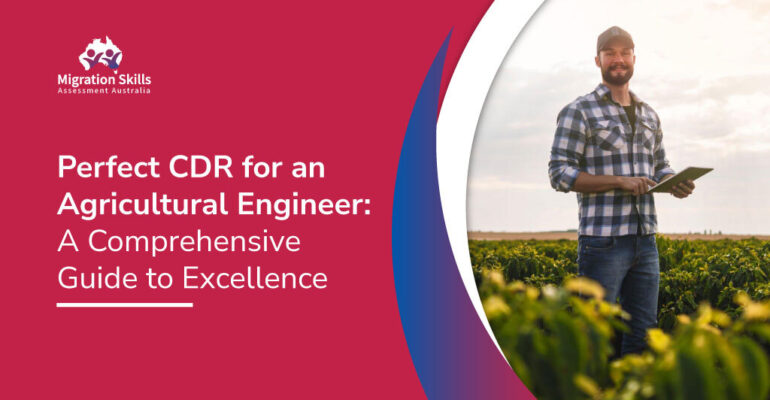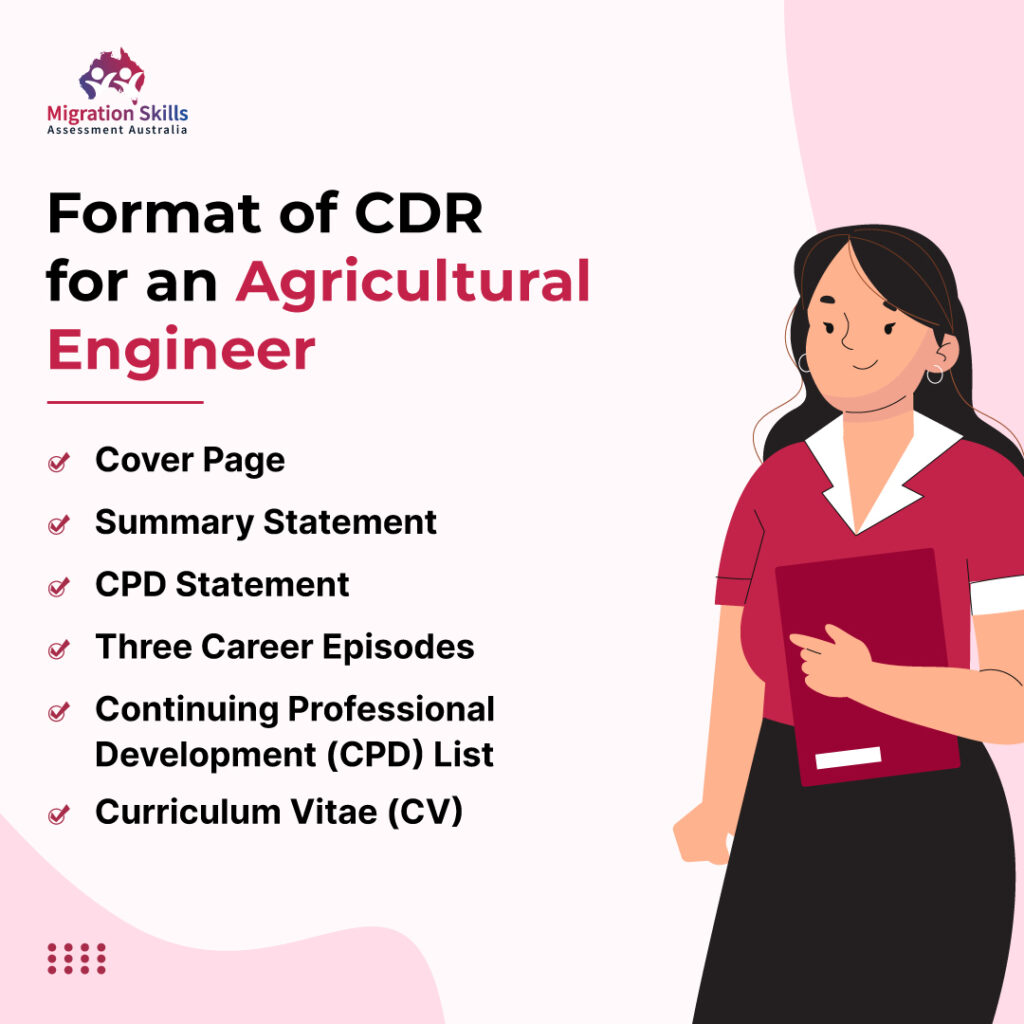How to write a perfect CDR for an Agricultural Engineer?

How to write a perfect CDR for an Agricultural Engineer?
The demand for skilled agricultural engineers is rising as the world grapples with food security, sustainability, and environmental conservation issues. As a leading agricultural nation, Australia offers a promising destination for aspiring agricultural engineers seeking a dynamic and rewarding career.
However, to secure skilled migration to Australia, one must submit a compelling Competency Demonstration Report (CDR) that showcases their expertise and suitability for the profession. As the demand for skilled professionals continues to rise, the Department of Home Affairs plays a crucial role in assessing Competency Demonstration Reports (CDRs) submitted by aspiring Agricultural Engineers seeking skilled migration to Australia.
Crafting a perfect CDR is essential to demonstrating excellence in the agricultural engineering field. Competency Demonstration Report (CDR) is crucial for every aspiring engineer seeking Skilled Migration to Australia. This document holds even more significance for agricultural engineers as it showcases their skills, knowledge, and experience in a pivotal sector in ensuring food security and sustainable practices.
This comprehensive guide delves deep into crafting the perfect CDR for agricultural engineers. We will explore the key components of the CDR, the essential skills and competencies required, and provide effective strategies to create a compelling narrative that resonates with the Engineers Australia (EA) assessment criteria.
Components of Competency Demonstration Report (CDR)
The CDR allows aspiring engineers to demonstrate their expertise and suitability for skilled migration to Australia. It comprises three key components:
a. Continuing Professional Development (CPD) Statement
A summary of the applicant’s professional journey, including training, workshops, certifications, and conferences attended to enhance their engineering skills.
b. Three Career Episodes
Detailed accounts of specific engineering projects or experiences showcasing the applicant’s field competencies.
c. Summary Statement
A cross-referencing document links the competencies demonstrated in the career episodes to the EA’s Stage 2 competency standards for Agricultural Engineers. Agricultural engineers are pivotal in advancing agricultural practices and technologies to meet the challenges of a growing global population and ensure environmental sustainability.
As a result, the CDR for an agricultural engineer should reflect a deep understanding of the field’s complexities, challenges and the engineer’s contribution to solving real-world agricultural issues.
Format of CDR for an agricultural engineer
An impeccable CDR is characterized not only by its content but also by its structure. Engineers Australia provides specific guidelines for formatting the CDR and adhering to them is essential. The structure typically consists of:

a. Cover Page
The cover page should include the following:
- The engineer’s name.
- The title is “Competency Demonstration Report.”
- The ANZSCO code (233912 for Agricultural Engineers).
- The engineering discipline (Agricultural Engineering).
- The date of submission.
b. Summary Statement
The summary statement is a critical component of the CDR as it provides a snapshot of how the career episodes align with the EA’s Stage 2 competency standards for Agricultural Engineers. The summary statement should reference the specific paragraphs in the career episodes where the evidence of each competency can be found.
c. CPD Statement
The Continuing Professional Development (CPD) statement should outline the engineer’s professional development activities over the last three years. It should include formal and informal learning details, such as workshops, conferences, seminars, courses, and on-the-job training, that have enhanced the engineer’s skills and knowledge.
d. Three Career Episodes
The three career episodes are the CDR’s heart and allow engineers to showcase their engineering skills and experiences. Each career episode should focus on a specific project or engineering experience and align with the EA’s competency standards.
e. Continuing Professional Development (CPD) List
The CPD list is a tabulated document that provides a detailed breakdown of the engineer’s professional development activities, including each activity’s date, duration, title, and description.
f. Curriculum Vitae (CV)
The ideal CV should be a brief document highlighting the engineer’s educational qualifications, work experience, and professional memberships.
Read More: Skillselect Visa Categories: Which visa pathway is Right for You? ✈️✈️
Identifying the Competencies
An Agricultural Engineer must identify and align their competencies with the EA’s Stage 2 competency standards to create a strong CDR. Some key competencies that are relevant for agricultural engineers include:
a. Sustainable Agricultural Practices and Environmental Management
Agricultural engineers are at the forefront of developing and implementing sustainable practices that promote environmental conservation and resource management. Demonstrating expertise in managing soil erosion, optimizing water usage, and mitigating the impact of agriculture on natural ecosystems is crucial.
b. Irrigation and Water Resource Management
Efficient irrigation systems are vital for agricultural productivity, especially in arid regions. An agricultural engineer should showcase their ability to design, implement, and manage irrigation systems that optimize water usage while ensuring crop yield and quality.
c. Crop and Soil Management
Agricultural engineers play a significant role in crop selection, cultivation, and soil fertility management. Demonstrating knowledge of crop rotation techniques, soil testing, and modern technology in precision agriculture is essential.
d. Farm Machinery and Equipment Design and Management
Modern agricultural practices heavily rely on advanced machinery and equipment. An agricultural engineer should highlight their expertise in designing, selecting, and managing agricultural machinery and equipment to enhance productivity and efficiency.
e. Project Management in the Agricultural Sector
Agricultural engineers often lead and manage complex projects, such as developing large-scale farms or implementing agricultural technology. Demonstrating project management skills, including planning, budgeting, and risk management, is crucial.
f. Research and Development in Agriculture
Innovations in agricultural engineering drive the industry forward. An agricultural engineer should showcase their involvement in research and development projects that aim to improve agricultural practices, such as developing new crop varieties or sustainable pest control methods.
g. Agricultural Product Quality and Food Safety
Ensuring the safety and quality of agricultural products is essential for public health and international trade. An agricultural engineer should highlight their knowledge of food safety standards, quality control processes, and compliance with relevant regulations.
Read More: How to Become an Australian Permanent Resident? ✈️✈️
Selecting the Right Career Episodes
Career Episodes are pivotal in highlighting an engineer’s abilities and achievements. When selecting the proper episodes, an Agricultural Engineer should keep in mind the following:
a. Relevance
Choose projects that align with the chosen occupational category and demonstrate your expertise in agricultural engineering.
b. Complexity
Opt for projects that showcase your ability to handle complex engineering challenges and demonstrate problem-solving skills.
c. Impact
Highlight episodes with a significant positive impact, such as increased crop yields, improved resource management, or sustainable practices.
d. Diversity
Include episodes that cover various aspects of agricultural engineering, providing a well-rounded perspective of your skills.
Read More: Migrate to Australia as a Civil Engineer: A comprehensive guide ✈️✈️
Writing the Career Episodes
Writing a compelling Career Episode requires meticulous planning and storytelling. Each episode should follow a specific structure:
a. Introduction
Introduce the background of the project, its objectives, and your role in the project.
b. Background
Provide context to the project, including relevant details about the location, stakeholders, and any challenges.
c. Engineering Activity
Describe your engineering work, including methodologies, calculations, and innovative approaches.
d. Personal Engineering Activity
Highlight your contributions to the project, emphasizing your problem-solving skills and technical expertise.
e. Summary
Conclude the episode by summarizing the outcomes and achievements of the project.
It’s essential to remember that the focus of each career episode should be on the engineer’s contributions to the project rather than providing a general overview of the entire project. Moreover, avoid using sensitive or proprietary information in career episodes, especially if it could violate any confidentiality agreements.
Showcasing Achievements and Outcomes
It’s crucial to highlight the outcomes and achievements of each project to make your CDR stand out. Use quantitative data, such as increased crop yield percentages, reduced water consumption, or cost savings, whenever possible.
Additionally, mention any recognition, awards, or positive feedback received for your contributions to the projects. Demonstrate your ability to implement sustainable agricultural practices with positive economic, social, and environmental impacts.
For example, if you were involved in a project that successfully introduced precision agriculture techniques leading to a significant reduction in pesticide usage and improved crop yield, include specific data to showcase the percentage reduction in pesticide usage and the corresponding increase in crop productivity.
1. Incorporating Technical Details
Agricultural engineering is a technical field, and the CDR should reflect a thorough understanding of the subject matter. Include relevant technical details such as engineering drawings, charts, graphs, and calculations to reinforce your expertise and showcase your problem-solving skills.
For instance, if you designed an automated irrigation system for a large-scale agricultural operation, describe the system’s technical specifications, including flow rates, pressure requirements, sensor technologies, and the control logic that enables precise water delivery to crops.
Visit: How to make an ideal CV for a skills assessment? 📑📑
2. Emphasizing Continuous Professional Development
The Continuing Professional Development (CPD) Statement is an opportunity to showcase your commitment to ongoing learning and professional growth. Please include details of any training, workshops, seminars, or certifications related to agricultural engineering and its sub-disciplines.
Explain how each professional development activity has contributed to enhancing your skills and knowledge in specific areas of agricultural engineering. For instance, if you attended a workshop on the latest advancements in precision agriculture, highlight the key takeaways and how you applied this knowledge in your subsequent projects.
Additionally, mention any participation in professional engineering associations, conferences, or symposiums where you engaged with fellow engineers, researchers, and industry experts to exchange ideas and get updated on the latest trends and innovations in agricultural engineering.
3. Reviewing and Editing
Once you have completed the CDR, reviewing and editing it is crucial. Ensure that the language is clear, concise, and error-free. Seek feedback from colleagues or mentors who can offer valuable insights to improve the document further.
Pay attention to grammar, punctuation, and formatting. Check for consistency in verb tenses and maintain a professional tone throughout the document.
Revise each career episode to ensure it addresses the specific competency elements outlined in the EA’s Stage 2 competency standards for Agricultural Engineers. The episodes should demonstrate your proficiency in each competency while highlighting your experiences’ diversity.
Read more: Competency Demonstration Report(CDR): Everything you need to know 📑📑
Conclusion
Crafting the perfect CDR for an Agricultural Engineer requires meticulous planning, a strong understanding of the EA’s competency standards, and the ability to effectively showcase one’s skills and achievements.
By following the guidelines outlined in this blog, aspiring agricultural engineers can present a compelling narrative highlighting their expertise, contributions, and potential to make significant contributions to the agricultural sector in Australia.
Remember, the CDR is not just a document; it represents your engineering journey and a stepping stone towards a promising future Down Under. An impeccable CDR reflects the essence of an agricultural engineer – a passionate problem solver, an innovator, and a steward of sustainable agricultural practices for a better and resilient future.


